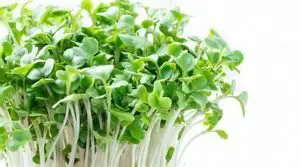Contents
A microgreen is a nutritious plant that can be easily grown without soil. It is a great idea if you are trying to avoid the mess at home and using no special equipment. The microgreens have a complete package of nutrition that can be used in soups, salads, and sandwiches.
An indoor gardener has limited space, time, and money, so it is important to find ways that are easy for the growth of plants. Those who want to satisfy their sense of planting by using simple methods like microgreens are focusing on fast-growing plants with a relatively low maintenance requirement. Cleaning, efficiency, and cost-effectiveness are all included in the growth of soilless microgreens. Harvesting healthy foods within two weeks is a plus as well.
Why Grow Microgreens Without Soil
Grows Easily In Water
Microgreen crops are easy to grow in water and eliminate the need to handle soil. They can absorb oxygen and other nutrients directly from the nutrient solution. It is also possible to add fertilizer to the water solution for additional nutrients and improve the result.
While some plants do not need a growing medium, it does not mean that growing in soil is a bad idea, as there are many benefits associated with soil. The first benefit of soil is that it retains more water compared to hydroponic systems.
By growing on soil, your baby greens receive quality nutrition and amounts of water. After obtaining the ideal amount of water and other elements, you can enjoy the elevated taste of your fresh greens.
A Busy Schedule
If you are a busy person and often forget to water your plants, then it is an easy way to grow your favorite kinds of micro-greens for tasty dishes. It is essential to give your indoor plants proper attention but sometimes life becomes too busy and they go neglected. They can be grown anywhere at your home, perhaps in the garage, the basement, the patio, or the balcony.
Nutrient Levels
You would be shocked to find out that microgreens can offer a very high nutritional value when compared to mature leaves of the same vegetable. These microgreens contain nutrients like carotenoids, ascorbic acids, and other vitamins.
Ideal Microgreens To Cultivate

Plants like spinach, beets, mustard, kale, swiss chard, coriander, parsley, sorrel, lettuce, basil, broccoli, and peas can be grown as microgreens. When broccoli microgreens and other varieties sprout a single set of true leaves, they are ready for harvesting.
It has been noted that some varieties, such as wheatgrass, kohlrabi, and kale, can grow well hydroponically and produce better crops in water as compared to growing in the soil. However, some plants, including peppers, potatoes, tomatoes, and eggplants, contain unhealthy elements in their stems, so you cannot consume them.
Growing Microgreens Hydroponically
Hydroponics is the practice of growing plants without soil. Plants can be grown in a pH range from 5.5 to 6.5. Use filtered water with the proper pH when growing soil-free microgreens. Alternatively, you may use boiled tap water instead of filtered water as long as it is clean. If you want to start growing your plants quickly, then you need healthy and clean water for this purpose. Your growing medium is now ready for use after draining the excess water. Soil-free plants will grow very quickly. Although you grow them in fresh water, you should wash them thoroughly before consuming them.
Hydroponic grow mats must be embedded into plastic trays (similar to a soil tray) measuring 10 x 20 inches. The grow mat should be properly moistened by pouring water into the entire tray.
Another option is a paper towel. Instead of using growing pads, you can use damp paper towels. If you fold it many times, you can make a thick layer. You may also use coconut coir which is cheaper, but growing mats are less messy and easier to use.
It is highly recommendable to use three tablespoons of seeds for a heavy crop. Three tablespoons of organic seeds are perfect for arugula, broccoli, radish, and mizuna. For best results, plant the microgreen seeds evenly.
Using a spray bottle, dampen seeds with evenly distributed mist. Next, take an empty tray with dark color but similar in size and mist it from inside with the help of a sprayer, and then place it upside down on the tray in which you will be growing microgreens. Providing extra moisture and humidity, this extra tray will shield your baby plants from excessive light and provide shelter from excessive heat.
A temperature range of 65 to 85 degrees Fahrenheit (18 to 30 °C) is optimal for germination. If you live in a cold area, choose a warm location such as a sunny windowsill for your tray. Water your seeds every 10 to 12 hours (about two times per day) with a spray bottle and don’t water the tray.
Your seeds will take 4 to 5 days to sprout true leaves, so place the tray where it gets 3 to 4 hours of direct sunlight and cover it. Rotating your tray is essential so the plants get even lighting. Water levels can be checked by pressing your finger on the pad. Just pour water on the pad and the sprouts at this point. If you intend to harvest them, try to do it late at night or early in the morning using a pair of scissors so that they stay fresh.
Does it make sense to grow microgreens without soil?
Compared to the soil growing method, growing beautiful microgreens in water will be cleaner but will take longer to harvest. The soil or potting mix provides a stable environment with consistent moisture and temperature. Growing microgreens in the soil provide a greater surface area for the roots to develop. The soil also can retain more water than pads so, in this way, it provides a better amount of moisture and nutrients.

